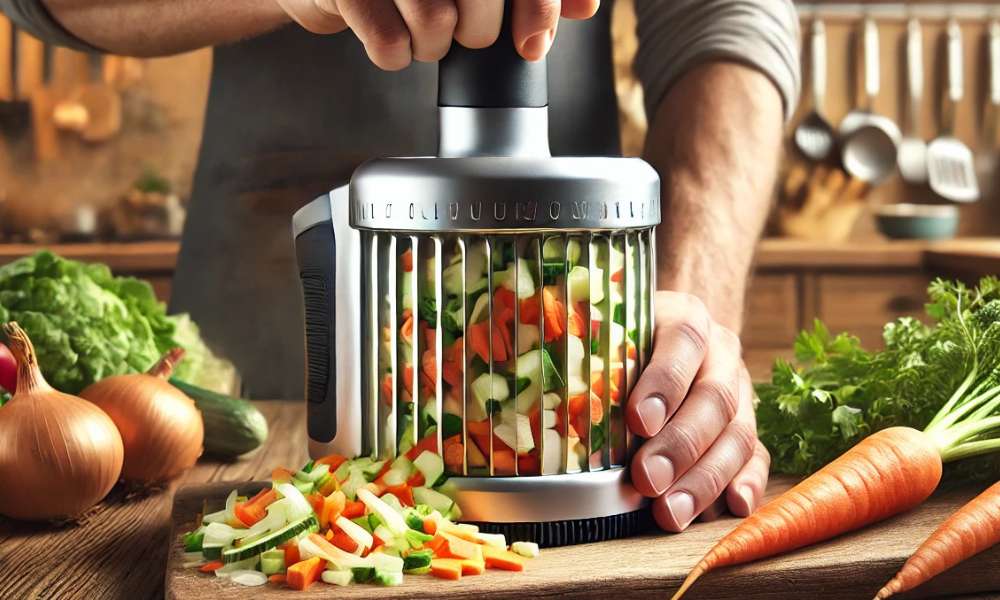A vegetable chopper is an essential tool for anyone who values efficiency in the kitchen. Whether you’re preparing a quick salad or tackling a complex recipe, knowing how to use a vegetable chopper can save time and ensure uniform cuts for a professional touch. From dicing onions to slicing zucchini, these handy devices streamline meal prep, reducing effort while enhancing precision. With various types available—manual or electric—each offers unique benefits for diverse culinary needs. This guide will walk you through everything you need to know about using a vegetable chopper effectively, ensuring safety, speed, and perfect results every time.
Choosing the Right Vegetable Chopper
Types of Choppers:
Manual Choppers: Ideal for those who prefer control and minimal use of electricity, manual choppers require physical effort but are celebrated for their portability and simplicity. However, they might not suit bulk or frequent chopping.
Electric Choppers: These are perfect for extensive use, capable of handling large volumes of food with little effort. They require power but offer unmatched speed and efficiency.
Features to Consider:
Blade Quality and Material: Opt for high-grade stainless steel blades for longevity and consistent performance.
Capacity and Size: Consider the quantity of food you typically prepare to determine the ideal chopper size for your kitchen.
Ease of Cleaning and Maintenance: Look for choppers that disassemble easily and are dishwasher safe to ensure hygiene.
Safety Features:
Locking Systems: Ensure that the chopper has a robust locking mechanism to prevent accidents.
Non-slip Bases: A rubber or silicone base can provide stability and prevent slippage during use.
Enclosed Blades: Especially in electric models, enclosed blades are crucial for safety, preventing accidental contact.
Preparing to Use Your Vegetable Chopper
Cleaning Before Use: Thoroughly wash all parts of the chopper before its initial use to remove any residues from manufacturing, ensuring food safety.
Assembling Your Chopper: Follow the manufacturer’s instructions carefully to assemble your chopper correctly, ensuring all parts are securely fastened to prevent mishaps.
Safety Precautions: Always use the pusher or guards provided, and never place fingers near the cutting mechanism. Regular checks for wear and tear on blades and other components can prevent accidents and ensure efficient operation.
How to Use a Vegetable Chopper
Basic Techniques: For optimal results, cut vegetables into uniform sizes that fit easily into the chopper. Firm pressure applied evenly will yield the best results.
Using a Manual Chopper: Place the vegetable on the chopper board, secure the top, and apply a firm, downward pressure. Repeat as necessary to achieve desired size.
Using an Electric Chopper: Ensure the chopper is plugged in and that the vegetables are positioned correctly in the container. Use the pulse function for controlled chopping or continuous mode for quicker results.
Advanced Tips: Experiment with dicing, mincing, and creating decorative cuts to elevate your culinary creations. Some choppers come with interchangeable blades suited for these tasks.
Maintenance and Care
Cleaning After Use:Immediately wash the chopper after use to prevent food from drying on the components, making it harder to clean.
Storage Tips:Store blades with protective covers and keep the unit in a dry area to avoid any potential damage or corrosion.
Troubleshooting Common Issues: Dull blades can often be sharpene if they are not serrate, whereas motor issues in electric choppers typically require professional servicing.
Recipes and Creative Uses
Simple Recipes:Use your vegetable cut to prepare dishes like quick salsas, salads, or slaws that require uniform pieces of vegetables.
Creative Uses:Beyond vegetables, try using your chopper for fruits, cheeses, or even nuts to make spreads and toppings.
Inspiring Ideas:Incorporate the chopper into your meal prep routine to reduce preparation time, allowing you to focus on other cooking tasks or even meal creativity.
Conclusion
The practicality and versatility of vegetable choppers make them invaluable tools in the modern kitchen. With the ability to significantly reduce prep time while ensuring precise cuts, these devices encourage culinary experimentation and efficiency. As you become more familiar with your vegetable cut, continue to explore new recipes and techniques to fully leverage its capabilities in your everyday cooking.
